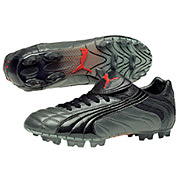
|
|
|
|
Go to the Playright Sporting Goods Catalog!!!!! 
  How To Buy A Soccer Ball
How To Buy A Soccer Ball
You can't play soccer without a soccer ball. But buying the right ball is not that simple. You have to choose the right size for your age and the right material for your needs. The first step in purchasing a soccer ball is determining the proper size for your age group. Many soccer leagues have different size requirements, so be sure to check with your coach to find out which is the proper size. Soccer balls come in three different sizes which range from size 3 to size 5. Size 3 balls are the smallest balls and are generally used for children under the age of 8. These balls are generally 23-24 inches in circumference and weigh between 11-12 ounces Size 4 balls are used for players between the ages of 8-12. Size 4 balls weigh between 12-13 ounces and have a circumference of 25-26 inches This is the international standard match ball for all ages 13 and older, including all adult play. The size 5 ball weighs between 14-16 ounces with a circumference of 27-28 inches Your choice for the cover of the soccer ball depends on how much you want to spend and your level of skill. Synthetic The best quality soccer balls are all made of synthetic materials. Synthetic balls offer superior feel and softness, but are generally less durable and less water-resistant than their polyurethane counterparts. They are also more expensive Polyurethane PU soccer balls offer the benefits of synthetics (for feel) and plastics (for durability). These balls are made of a durable synthetic material that offers a feel much like leather. These balls are very durable - only slightly less than PVC, scuff-resistant, and water-resistant. They often have a glossy coating for additional protection PVC PVC balls are molded out of a plastic-like PVC material and are generally the least expensive balls. These are very durable, scuff-resistant and water-resistant but offer less feel and softness than polyurethane balls. They often have a glossy coating for additional protection. The number of panels -- the different segments that make up the outside of the ball -- varies for each design. A 32-panel ball is the most common and is the type used in most professional matches. Other traditional designs are 18 and 26-panel constructions, used in various professional leagues, including Major League Soccer. Fewer panels generally means the ball can be curved more when kicked because of less stability to the cover. Panels can be either stitched or glued: Stitched The highest quality balls are stitched with a polyester or similar thread. High-end balls are hand-stitched, while most mid-priced balls are machine-stitched. Glued Lower-end, practice balls generally have the panels glued together onto the lining. These offer a harder feel and are generally less expensive than stitched balls Linings are inserted between the cover/panels and the bladder to provide shape, feel, control and structure. Higher end balls usually have four layers of polyester and cotton lining for superior shape retention and durability. Mid-level balls generally are comprised of two or three layers of cotton and two layers of polyester. Lower-priced balls generally are constructed of two layers of polyester. The bladder is the inside part of the ball that is filled with air. Most balls use butyl valves for air retention, with higher end balls using a silicone-treated valve for superior performance. Don't forget to buy a small pump and some needles to keep your ball inflated. There are two basic types of bladders: Latex These traditional bladders are soft and offer a good feel. Latex bladders are generally used on higher-quality balls. They do not hold air as well and generally require more frequent filling Butyl These bladders retain air better than latex bladders. Most mid-priced soccer balls utilize a butyl bladder that combines 70-80% butyl with rubber |